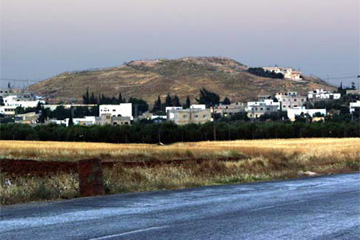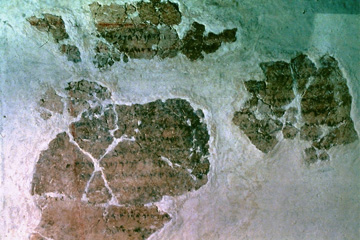Archaeology and the Bible
Numbers
| Tel Hesban | 31 48 02.15N 35 48 32.75E | The excavations on the summit of the tel can be clearly seen. |
The Heshbon Mystery

| |
| Tel Hesban, photographed from the main road. |
There are two other sites nearby which could be Heshbon from the time of Moses, Tel Umayri and Tel Jalul. Horn favoured Tel Jalul because the Iron I buildings were built over six feet of ash, which he assumed was the remains of Sihon's capital. Tel Umayri, which is a mere six miles from Tel Hesban, has a major settlement from the Early Bronze but no fortifications of that date. This is the city we would identify as Sihon's Heshbon. The Early Bronze settlement was followed by a very well defended Middle Bronze city, probably the Israelites defending themselves against attack by the resurgent Ammonites.
It is not unknown for cities to migrate like this: the original site falls out of favour as climate changes, rivers or trade routes move, the original city is destroyed and survivors build on a new site, and so on. Unfortunately we do not know the original name for Tel Umayri, not even for its later Greek and Roman periods. It may not have had a name, for by then it was nothing more than a large villa and agricultural estate. By that time Tel Hesban had taken over the name and importance of Heshbon.
Talking donkey
If there is one story in the Bible which cries out to be recognised as a myth, it is surely the story of Balaam and his talking donkey. Curiously, although there is no archaeological evidence for the donkey, there is support for the story of Balaam.
A Dutch expedition from the University of Leiden worked at Tel Deir Alla, a site on the east bank of the Jordan River. In 1967 an Arab foreman, Ali Abdul Rasul, noticed that the bits of plaster he was uncovering had writing on them, which brought the expedition to a shuddering halt as all efforts concentrated on uncovering and restoring the delicate plaster fragments. In all, 119 pieces of plaster were recovered, some little more than the size of a fingernail.
Archaeologists believe that the plaster was originally applied to a nearby mud-brick wall to form two panels onto which the inscription was written using pen and ink in red and black. When, following an earthquake, the wall needed repairs, the plaster was removed and buried in two pits instead of just being discarded on the ground, implying that the inscription was somehow regarded as sacred.

| |
| Part of the reconstructed Balaam Inscription from Tel Deir Alla. |
The style of the writing as well as carbon-14 dating puts the inscription at around 800 BC - in other words, around the time of Ahab. On the other hand, if the earthquake that damaged the inscription is the same as the one mentioned in the Bible, then it occurred during the reign of King Uzziah of Judah and must be dated to 750 BC, which is within the margin of error of the carbon-14 dating.
The script is a type of cursive Aramaic and the careful writing, as well as the use of guidelines, indicates that it was done by a professional scribe. Originally there were four panels, but it would seem that the earthquake came while only one and a half panels had been filled with writing: in other words, we have an incomplete inscription and given the contents of the text, it may be that the people who were around at the time felt that the writing itself was responsible for the earthquake! This would explain why they buried the plaster fragments so carefully.
The language is believed to be a form of Aramaic that comes from southern Syria, which would accord with the Biblical statements regarding Balaam's home town. The use of archaisms within the text indicate that the inscription is based on or is a copy of a much older document, though the exact age is not yet determined.
One of the main problems confronting the restorers who worked on the plaster fragments was arranging them to make a coherent text. Some pieces obviously fitted together, others appeared to be completely separated. Most scholars are happy with the present restoration, though there are still areas of disagreement.
The text begins with the word, "The words of Balaam, son of Beor, the man who was a seer of the gods." It tells of how Balaam received a terrifying vision foretelling that the people were to be punished by "a fire of chastisement". He was so distressed by what he had seen that he couldn't eat or drink, prompting those around him to question what he had seen. After this the text becomes too fragmentary for any secure translation, but the restorers believe that Balaam went on to offer to avert the coming judgement, either by magic or by interceding with the gods.
Clearly this is a story about Balaam that is completely independent of the Bible story. There are no donkeys - talking or otherwise, no calls to curse anyone - quite the opposite, in fact. What the stories have in common, however, is the name and the implication that Balaam was fond of money. Whether or not he actually had such a dream or vision, he quite clearly intended to profit from it by inducing the terrified people to pay him to avert the coming disaster.
In other words, insofar as archaeology can "prove" anything, it supports the Biblical story of a respected or even feared prophet, believed to have special powers with the gods. Such a person might well have been invited to invoke the gods against Israel and would undoubtedly have demanded a hefty fee for his services.
the present restoration Below is the reconstruction and translation of the first nine lines by Professor Andre Lemaire. Words enclosed in square brackets are missing but are reconstructed, often from elsewhere in the text. For example, the words "Balaam son of Beor" in line 1 are represented only by "lm....r" but are reconstructed from line 4, where they appear in full.
1. Inscription of [Ba]laam [son of Beo]r, the man who was a seer of the gods. Lo, the gods came to him at night and [spoke to] him
2. According to these wor[ds], and they said to [Balaa]m, son of Beor thus: "There has appeared the last flame, a fire of chastisement has appeared!"
3. And Balaam arose the next day [ … several?] days [ … ] and he cou[ld not eat] and he wept
4. intensely and his people came to him and s[aid] to Balaam, son of Beor: "Why do you fast and why do you weep?" and he
5. said to them: "Sit down! I shall show you how gre[at is the calamity!] and come, see the deeds of the gods! The gods have gathered
6. and the Mighties [Shaddayin] have fixed a date, and they said to Sha[ma]sh [/the sun]: 'Sew, shut the skies with your cloud! there, let there be darkness and no shi-
7. ning … ? … , for you will provoke terror [by a clo]ud of darkness, and do not make noise forever but [in its place?] the swift,
8. the bat, the eagle and the peli[can,] the vultures, the ostrich and the s[tork and] the young falcons, and the owl, the chicks of the heron, the dove, the bird of prey,
9. the pigeon and the sparrow, [every bird of the s]kies, and [on the earth] down, in the place where the [shepherd's] crook was leading the ewes, hares eat
10. [alto]gether free[ly … ]
It has been suggested that the passage has been copied from a "Book of Balaam" which may have existed, just as the Bible refers to a "Book of Jasher" and "Book of Gad". Return
http://www.biblearchaeology.org/post/2008/09/Israel-in-Egypt.aspx




